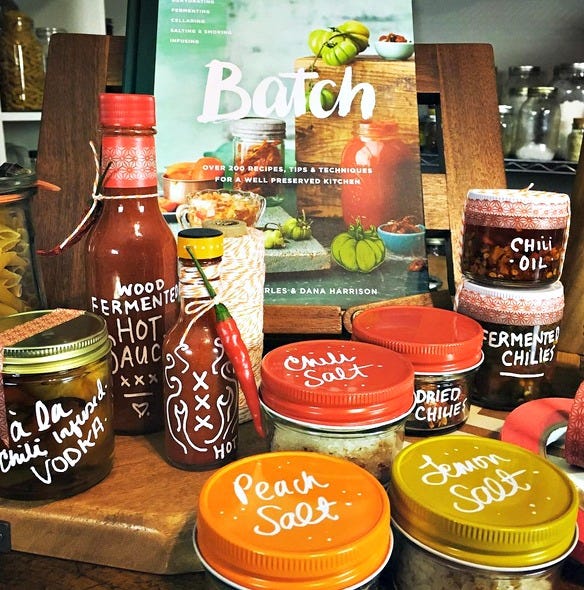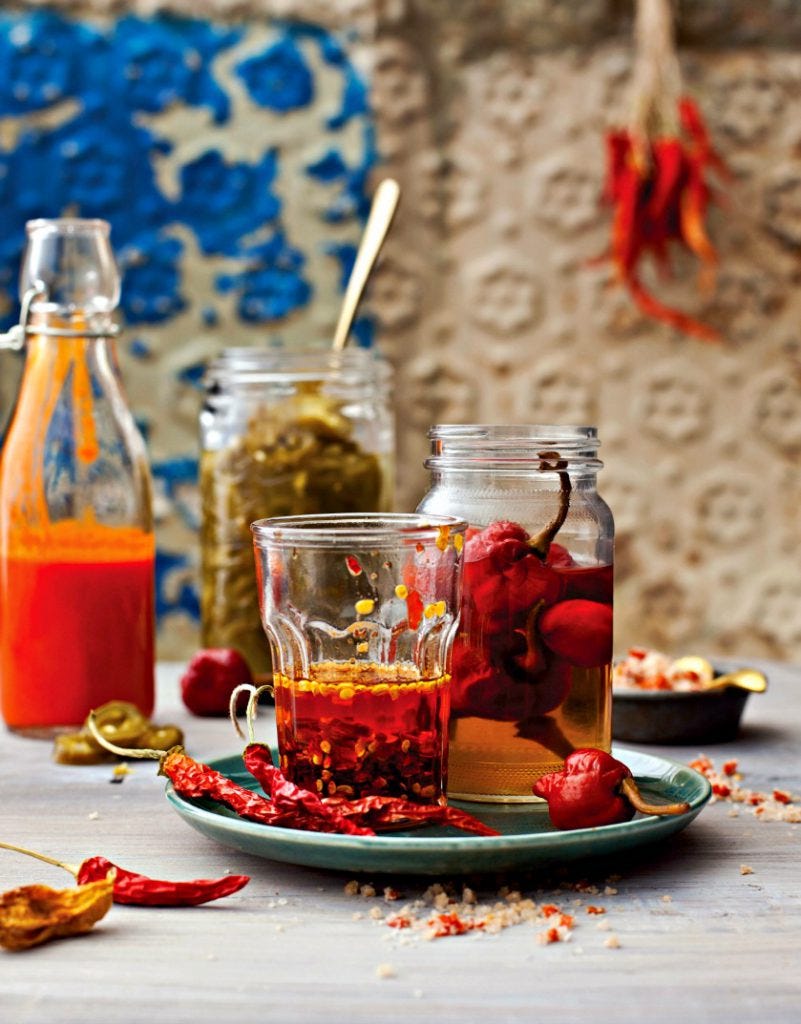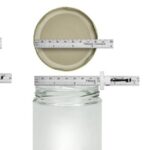
Preserving Chili Peppers with Batch
(Updated – August 26, 2020)
We are excited to team up with the authors of Batch again and continue to enjoy Joel MacCharles & Dana Harrison’s adventures with food and preserving and are so pleased to share a recipe for Wood-Fermented Hot Sauce from their book Batch. We hope you’ll enjoy preserving chili peppers with Batch as much as we did!
Batch has a very intentional nature and a more holistic perception of preserving, which is evident in the Batch-It recipes. These are 2 or more recipes that start out with the same treatment, but yields different preserves.
This book will help you add more variety to your preserving, to make more from scratch, to waste less while enjoying the process, and not feel like you’ve spent the entire day over a steaming kettle. It is clear that they want to help you feel very productive and proud of what you’ve accomplished in your kitchen, no matter how humble it may be!
Watch this demo to learn how to preserve chili peppers with Batch authors, Joel MacCharles & Dana Harrison. In this 15 minute demo you learn how to make chili salt, fermented hot sauce, chili oil, infused chili vodka, tips to dry chili peppers and more.
Let’s take a closer look at a how Dana & Joel packaged some of those great preserves from the video. We love how they color coded the different salts with corresponding lid colors. The 4oz. tapered jars are a perfect container for salts, it doesn’t have shoulders so its a perfect style jar for grabbing a pinch of salt. Joel’s wood fermented hot sauce stands tall in our woozy jars – which range in size from 1.7oz to 10oz. His chili oil is packaged in our straight sided 4oz jars. If you are considering gifting some preserves for the holiday, take a tip from Well Preserved, they used paint pens to label – since it washes off when your done, and washi tape & bakers twine to dress these preserves up!
If you are considering gifting some preserves for the holiday, take a tip from Well Preserved, they used paint pens to label – since it washes off when your done, and washi tape & bakers twine to dress these preserves up!
Wood–Fermented Hot Sauce
We’ve received special permission from Dana and Joel to share the recipe for Wood-Fermented Hot Sauce from the Chili Pepper section of the book.
Excerpted from Batch: Over 200 recipes and Techniques for a Well-Preserved Kitchen. Copyright © 2016 Joel MacCharles and Dana Harrison. Published by Appetite by Random House, a division of Random House of Canada Limited, a Penguin Random House Company. Reproduced by arrangement with the Publisher. All rights reserved.
YIELD: 2 quarts pure hot sauce, up to 4 quarts if you dilute with vinegar to lessen heat.
EFFORT: 45 minutes
ELAPSED: 4-6 weeks
EAT: within 1-2 years
INGREDIENTS:
4 lb hot peppers (mix and match for more complex flavors!)
6 Tbsp coarse salt
3 whole bulbs garlic, cloves separated and peeled
1–2 quarts filtered water
YOU WILL NEED:
Large container such as a crock or cookie jar
A plate to use as a weight to submerge the peppers
2 cups wood chips Cheesecloth Kitchen gloves
*Jars – Fillmore Container recommends its Woozy Jar Collection , or Swing Top Jars.
Making your own hot sauce is fantastically simple and a great gateway to preserving. If you’re a chili head but haven’t worked with hot peppers, this recipe is a perfect place to start!
1 Cut the tops off the peppers. I use gloves for the entire process but always manage to rub my eyes . . . or worse!
2 Place the garlic in your fermenting vessel.
3 Add the peppers then the salt and use your hands to mix.
4 Place your weight on top of the peppers and let sit overnight, covered loosely.
5 Toss the wood chips in a large colander and shake to remove any small bits.
6 Optional: toast the wood chips in a frying pan, stirring often. This can get smoky if you don’t watch it closely.
7 Pour the wood chips (cooled, if you toasted them) onto a sheet of cheesecloth. Create a tea bag by tying the cheese- cloth multiple times. You don’t want it to open, as wood chips will be almost impossible to remove from the sauce and will ruin it.
8 Place the wood chip tea bag under the weight, and add water to submerge everything.
9 Ferment for five to thirty days, checking the brine daily after two or three days. Remove the wood when you are happy with the taste; if you leave it in for the entire time, it may become too “woody.” As with any ferment, remove foam or mold as it appears. The peppers will soften in time; I move to the next step at the first sign that some have gone limp.
10 To make the hot sauce, puree the peppers in a blender. Add more brine to smooth the flavors (it is arguably the best part). You can also cut it with up to 50% vinegar.
11 Place in clean jars and store in the fridge.
CENTER OF THE PLATE : Leftover brine? Use it to marinate meat or tofu, or reduce to make a spicy concentrate.





His cutting sizes were blocked by the jars I will I could see the sizes and what lid he used and he did not say how to jar them like a home style in the boiling water
Hi Joe,
None of these were for the waterbath (i.e. in boiling water). We do 7 styles of preserving and the boiling water is just 1. The recipes for salt are curing (they can be left on the counter), the ferments (hot sauce) are fermented on the counter but most store in the fridge, the dehydrated hot peppers can be stored in a cabinet like other spices, the chili in vodka can also be left on the shelf and the chili oil (the last two are infusions) is one for the fridge. None need to be waterbathed and you can cut them any size. 🙂
Joel
This is fascinating. What type of wood chips? Where do I obtain them?
Hi Toni!
Thanks for the comment!
We use food chips that occur when splitting wood with an axe but have also used wood chips that one uses for smoking (you can buy them at a BBQ supply store or online). 🙂
Joel
I have stopped making hot sauce with vinegar, and exclusively ferment. I think the flavor is much better, and allows the pepper itself to stand out front and center. I make straight habanero, ghost, chile de arbol, and also batches of a little bit all the peppers in my harvest.
It’s been my experience that vinegar does not lessen the heat, rather it usually intensifies the heat. Sugar will reduce the heat pretty dramatically. Removing seeds and most importantly membranes greatly reduces heat. To me heat is important, but taste is at the very top of my concerns. I love the hot pepper, and I want it to be front and center. Most of my sauces are peppers, salt and water. Fermentation has run from a few weeks to 6 months.
I will occasionally make a garlic / pepper sauce that is more of a paste than pourable sauce. But I stick to minimal ingredients.
This is a great article! I have thought that maybe an oak cask is in my future.